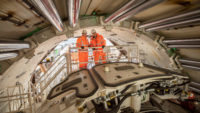The U.K. kicked off one of Europe’s biggest transportation projects with $8.6 billion in publicly funded contracts awarded on July 17 for the first phase of the 565-kilometer HS2 high speed railroad between London and points in northeast and northwest England. But for Britain’s other megaprogram, the 3,320-MW Hinkley Point C nuclear-power-plant project, which includes private financing, trouble is brewing as construction begins.
The first-phase HS2 contracts, to cover 225 km of track and 47 km of tunnels between London and Birmingham, will launch the estimated $73-billion program’s three planned phases. The seven awarded contracts “will support 16,000 jobs … and will create opportunities for thousands of [companies],” said David Higgins, chairman of HS2 Ltd., the government project firm.
Two contracts for the line’s northern third went to a joint venture of Balfour Beatty Group Ltd. and units of VINCI Group for $3.3 billion. Awarded southern-tier contracts worth $2.1 billion was the Skanska Construction U.K. Ltd., Costain Ltd. and STRABAG A.G. team. Of three central-area contracts, one went to the Bouygues Travaux Publics S.A., VolkerFitzpatrick Ltd. and Sir Robert McAlpine Ltd., team for $1.3 billion. Carillion Construction with Eiffage Genie Civil S.A. and Kier Infrastructure and Overseas Ltd. won two jobs, worth $1.8 billion. The win boosted Carillion, which just reported $1.1 billion of losses on U.K., Middle East and Canadian jobs, prompting the CEO’s departure.
Contractors now have over a year to add detail on schemes by HS2 Ltd. design firms. When target prices are set for the work, construction will start—likely by early 2019—and will finish in 2026. By then, the 69-km HS2a spur in the northwest would be nearly complete. With the detailed HS2b route just announced, the government expects the 150-km spur to Manchester and the 185-km spur to Leeds to be finished by 2033. While the contracts are an industry bonanza, HS2 opponents latched onto a gloomy assessment by the U.K. Infrastructure and Projects Authority that “successful delivery of the project is in doubt, with major risks or issues apparent.” The U.K. Dept. for Transport says the review “reflects the overall complexity of the project and should be seen in the light of very significant progress made.”
But the risk level appears higher on the Hinkley Point C nuclear plant, says the National Audit Office, which is independent of government. The project exposes the U.K. “to a high-cost and risky deal in a changing energy marketplace,” says Amyas Morse, its CEO. In a June report, the office said the government had “not sufficiently considered” costs and risks for consumers beyond 2030. Under contracts signed last fall, Nuclear New Build Generation Co. Ltd. will build and operate the plant. The firm is 66.5% owned by Electricité de France (EdF); China General Nuclear Power Group owns the rest.
To get the project off the ground, the government in 2013 agreed to provide various financial guarantees and a “contract for differences,” securing for the firm a power price of $121 per MW (at 2012 prices) for 35 years. Nuclear New Build bears all construction risk. Auditors question transferring that risk without assessing the value of alternative procurement routes. The audit office also highlighted the unproven track record of the EPR pressurized water reactor design, among uncertainties.
With Hinkley Point C contracts signed last fall, site contractors cast the first concrete in March and have begun erecting 50 tower cranes. But already there are slippages. EdF recently conceded that the first generating unit is at risk to run 15 months late, and the second nine months behind. EdF raised the forecast cost by $2 billion over the budget to $25.6 billion at 2015 prices. But at this early stage, “it will not be known for decades whether Hinkley Point C will be value for money,” the audit report says.







Post a comment to this article
Report Abusive Comment